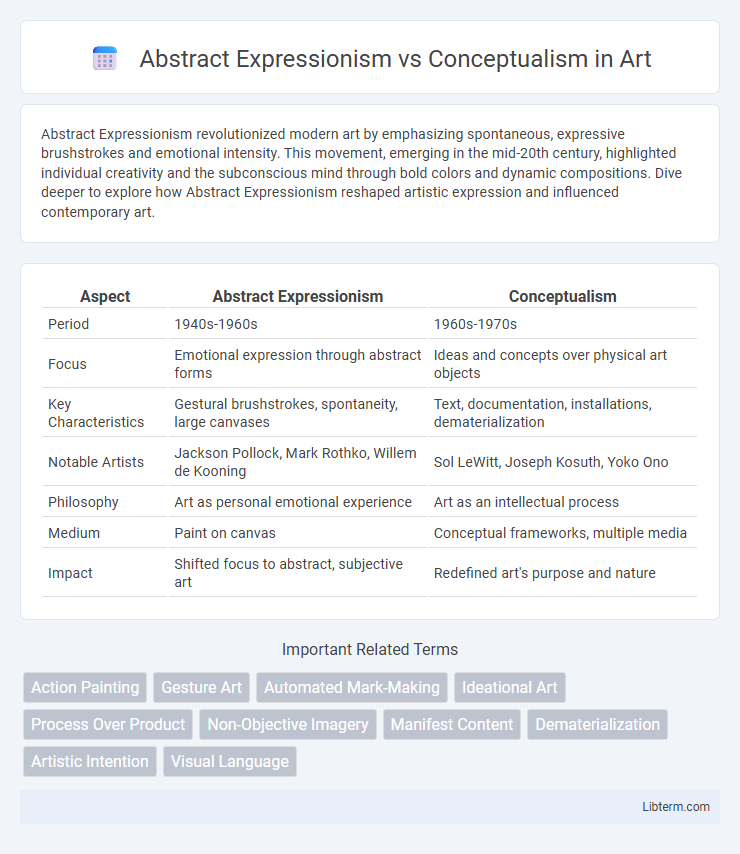Abstract Expressionism revolutionized modern art by emphasizing spontaneous, expressive brushstrokes and emotional intensity. This movement, emerging in the mid-20th century, highlighted individual creativity and the subconscious mind through bold colors and dynamic compositions. Dive deeper to explore how Abstract Expressionism reshaped artistic expression and influenced contemporary art.
Table of Comparison
| Aspect | Abstract Expressionism | Conceptualism |
|---|---|---|
| Period | 1940s-1960s | 1960s-1970s |
| Focus | Emotional expression through abstract forms | Ideas and concepts over physical art objects |
| Key Characteristics | Gestural brushstrokes, spontaneity, large canvases | Text, documentation, installations, dematerialization |
| Notable Artists | Jackson Pollock, Mark Rothko, Willem de Kooning | Sol LeWitt, Joseph Kosuth, Yoko Ono |
| Philosophy | Art as personal emotional experience | Art as an intellectual process |
| Medium | Paint on canvas | Conceptual frameworks, multiple media |
| Impact | Shifted focus to abstract, subjective art | Redefined art's purpose and nature |
Origins of Abstract Expressionism
Abstract Expressionism originated in the 1940s in New York City, emerging as the first major American avant-garde movement. Influenced by European surrealism and the trauma of World War II, artists like Jackson Pollock and Willem de Kooning emphasized spontaneous, gestural brushstrokes to convey emotional intensity. This movement laid the foundation for post-war American art, contrasting with Conceptualism's later focus on ideas and language over traditional painting techniques.
Emergence of Conceptualism
Emerging in the late 1960s, Conceptualism challenged the material focus of Abstract Expressionism by prioritizing ideas over visual form, emphasizing art as a vehicle for intellectual engagement rather than purely aesthetic experience. Artists like Sol LeWitt and Joseph Kosuth foregrounded language, documentation, and instructions, shifting the artwork's value from physical objects to concepts and processes. This paradigm shift marked a critical departure from the emotional intensity and gestural brushwork characteristic of Abstract Expressionism, inaugurating a new era of art defined by dematerialization and theoretical inquiry.
Key Philosophies and Ideals
Abstract Expressionism emphasizes spontaneous, subconscious creation and emotional intensity, prioritizing the artist's individual gesture and physical engagement with the medium. Conceptualism centers on the primacy of ideas over aesthetic form, challenging traditional art objects by highlighting intellectual inquiry and the dematerialization of the art object. Both movements redefine art's purpose, with Abstract Expressionism rooted in personal expression and Conceptualism in critical theory and language systems.
Influential Artists of Each Movement
Abstract Expressionism features influential artists such as Jackson Pollock, known for his drip painting technique, and Mark Rothko, famous for his large color field compositions. Conceptualism includes pioneers like Sol LeWitt, who emphasized ideas over form, and Joseph Kosuth, recognized for his use of language and definition as art. Both movements revolutionized 20th-century art by challenging traditional aesthetics but focused on different aspects: Abstract Expressionism on emotional intensity and Conceptualism on intellectual engagement.
Techniques and Materials Used
Abstract Expressionism emphasizes spontaneous, gestural brushstrokes and dynamic use of oils and acrylics on canvas, often incorporating large-scale canvases and impasto techniques to convey emotion. Conceptualism prioritizes the idea over materiality, employing mixed media, photography, text, and found objects as integral components, with techniques including installations, performance art, and readymades. The contrast lies in Abstract Expressionism's focus on physical paint application and material presence versus Conceptualism's use of materials as vehicles to express intellectual concepts and provoke viewer interpretation.
Aesthetic Differences Explained
Abstract Expressionism emphasizes spontaneous, dynamic brushwork and vibrant color fields to evoke emotional intensity and individual expression. Conceptualism prioritizes ideas and concepts over visual aesthetics, often utilizing minimalistic or non-traditional materials to challenge traditional art forms. The primary aesthetic difference lies in Abstract Expressionism's focus on sensory experience versus Conceptualism's engagement with intellectual inquiry.
Role of Emotion vs. Idea
Abstract Expressionism centers on the intense emotional experience conveyed through spontaneous, gestural brushstrokes, emphasizing the artist's psyche and feelings as the core of the artwork. In contrast, Conceptualism prioritizes the idea or concept behind the work, often minimizing emotional expression to foreground intellectual engagement and the art's underlying message. This fundamental difference highlights Abstract Expressionism's focus on personal emotion as art's substance, while Conceptualism elevates thought and concept as the primary artistic value.
Impact on Contemporary Art
Abstract Expressionism revolutionized contemporary art by emphasizing emotional intensity and spontaneous, gestural brushstrokes, influencing artists to explore personal expression and large-scale compositions. Conceptualism shifted the focus from traditional aesthetics to ideas and processes, encouraging art as a medium for intellectual engagement and challenging the art market's commercial values. The combined impact of both movements fostered diverse artistic practices centered on innovation, critical thought, and expanded definitions of art in the contemporary era.
Critical Reception and Legacy
Abstract Expressionism received critical acclaim for its emphasis on emotional intensity and spontaneity, marked by artists like Jackson Pollock and Willem de Kooning. Conceptualism, emerging in the 1960s, challenged traditional aesthetics by prioritizing ideas over visual form, with figures such as Sol LeWitt and Joseph Kosuth facing initial skepticism but later gaining recognition. The legacy of Abstract Expressionism lies in its influence on post-war American art, while Conceptualism reshaped contemporary art discourse by validating intellectual engagement as artistic practice.
Lasting Influence on Art Movements
Abstract Expressionism's lasting influence is evident in its emphasis on spontaneity, emotional intensity, and large-scale works, shaping movements like Neo-Expressionism and Action Painting. Conceptualism redefined art by prioritizing ideas over aesthetic form, impacting contemporary art practices such as Installation Art and Performance Art. Both movements fundamentally shifted artistic priorities, fostering expanded definitions of creativity and expression in postmodern art.
Abstract Expressionism Infographic

 libterm.com
libterm.com